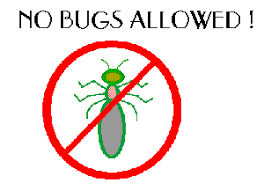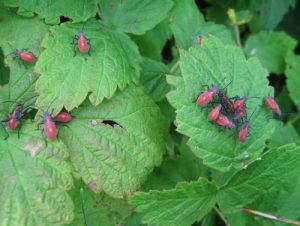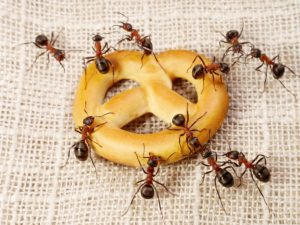The ants go marching two by two. A childhood song that we all know and love but not so funny when those ants go marching into your home. Or any bug for that matter. You could be some of the lucky ones that never deal with bugs in the home, but when those bugs do march in, the damage could cost thousands.
There are simple ways to help protect your home from all sorts of bugs before you need to call in the big guys to spray. Houselogic.com makes these simple steps to keep your bugs bugging out out your home!
Start outside
 Termites eat wood and carpenter ants tunnel into wood to nest. So remove piles of wood and other debris from around your home. The same goes for rotted stumps and logs. Keep firewood at least 20 feet away and five inches off the ground. And never bury wood scraps or waste lumber.
Termites eat wood and carpenter ants tunnel into wood to nest. So remove piles of wood and other debris from around your home. The same goes for rotted stumps and logs. Keep firewood at least 20 feet away and five inches off the ground. And never bury wood scraps or waste lumber.
Maintain at least 6 inches of clearance between soil and structural wood to prevent decay, which attracts carpenter ants, and to make it tougher for termites to find their next meal.
Keep it dry
Termites, carpenter ants, and powderpost beetles thrive in moist areas, so maintain a Sahara zone around your home’s perimeter.
In general, you shouldn’t have any vegetation—bushes, shrubs, vines, trees—touching the house, which can trap moisture that causes rot and attracts pests. Many pests use vegetation as a bridge between the ground to the walls and roof of your home.
Keep foundation plantings (shrubs, bushes, perennials) and wood mulch at least 18  inches away from the foundation. Prune trees, bushes, and vines that touch or overhang the house. And don’t plant anything close to your home that’s aphid-prone, such as peonies or roses. That’s like ringing the dinner bell for carpenter ants, which feed on honeydew, a sweet liquid produced by aphids.
inches away from the foundation. Prune trees, bushes, and vines that touch or overhang the house. And don’t plant anything close to your home that’s aphid-prone, such as peonies or roses. That’s like ringing the dinner bell for carpenter ants, which feed on honeydew, a sweet liquid produced by aphids.
Even an infrequent puddle close to the house can become an oasis for pests on the prowl for food, so take measures to direct water away from the house. Drain puddles, don’t overwater flower beds, point sprinklers away from the structure, and make sure the ground near the foundation slopes away from your home. Use drain tile if the site is flat.
Clean gutters so they don’t overflow. Use downspout extensions and splash blocks to direct rainwater runoff away from the foundation. Fix dripping faucets, water pipes, and air conditioning units. Even small leaks can contribute to wood rot and moist foundations that pests find irresistible.
Deny access into your home
The tiniest gap or crack can become an express lane for pests—and not only insects. “If you can push a pencil through a hole, a mouse can get through it,” says Greg Bauman, senior scientist with the National Pest Management Association.
Inspect your home’s envelope (walls, doors, windows, roof) for possible points of entry as well as moisture-inducing leaks. Use caulk or epoxy to seal any cracks in the foundation or gaps in the structure. Use steel wool or hardware cloth (1/4-inch wire mesh) to block any openings where wires, pipes, and cables come into or out of the house.
Should you detect any moisture damage, repair it promptly. Carpenter ants flock to deteriorating wood, but often move from decayed wood into sound wood as the colony expands. Replace punky fascia, soffits, and shingles. While you’re at it, paint weathered and/or unfinished wood to stop carpenter bees from drilling holes to build their nests.
Ventilate attics and crawl spaces, and make sure vents aren’t blocked by debris or vegetation. Good air flow prevents the buildup of moisture. Cover any exposed earth in the crawl space with a plastic vapor barrier.
Make sure roof and foundation vents are protected with hardware cloth. Install screens on all floor drains and windows. And while you’re at it, caulk or install weather-stripping around windows and doors as well. Close any gap between your garage door and the floor by attaching a door sweep. And keep the door closed.
Be inhospitable
If pests do get inside, they’ll usually die or skedaddle if they can’t find anything to eat or drink.
 Carpenter ants will eat almost anything you do, but are especially fond of sweet and greasy food. Put kitchen waste in a sealed trash can, sweep up crumbs, and wipe up spills right away. Termites typically feed on wood, but will eat anything with cellulose, so never store paper or cardboard—or wood—in the crawl space.
Carpenter ants will eat almost anything you do, but are especially fond of sweet and greasy food. Put kitchen waste in a sealed trash can, sweep up crumbs, and wipe up spills right away. Termites typically feed on wood, but will eat anything with cellulose, so never store paper or cardboard—or wood—in the crawl space.
Deal with interior moisture, too. Inspect the base of toilets, around bath tubs and shower stalls, and areas where pipes go through walls, such as under sinks. Repair any leaks and wrap any pipes that produce excess condensation.
Check behind and under washing machines and dishwashers, which are notorious for leaks, to make sure there’s no condensation or old moisture damage. Fix leaky faucets; in some cases, replacing a simple O ring might not only save water, but also stave off a potential invasion of pests.
